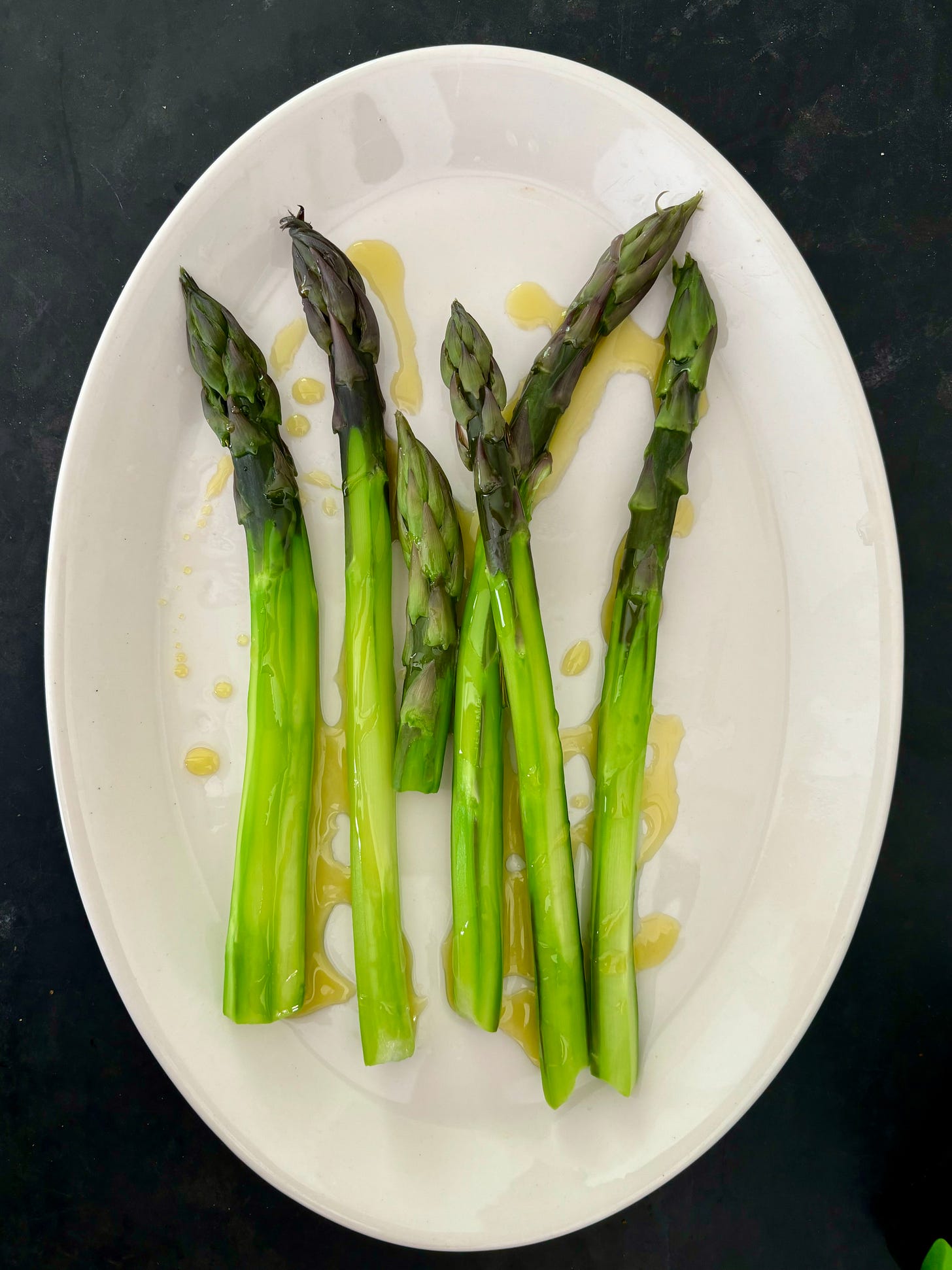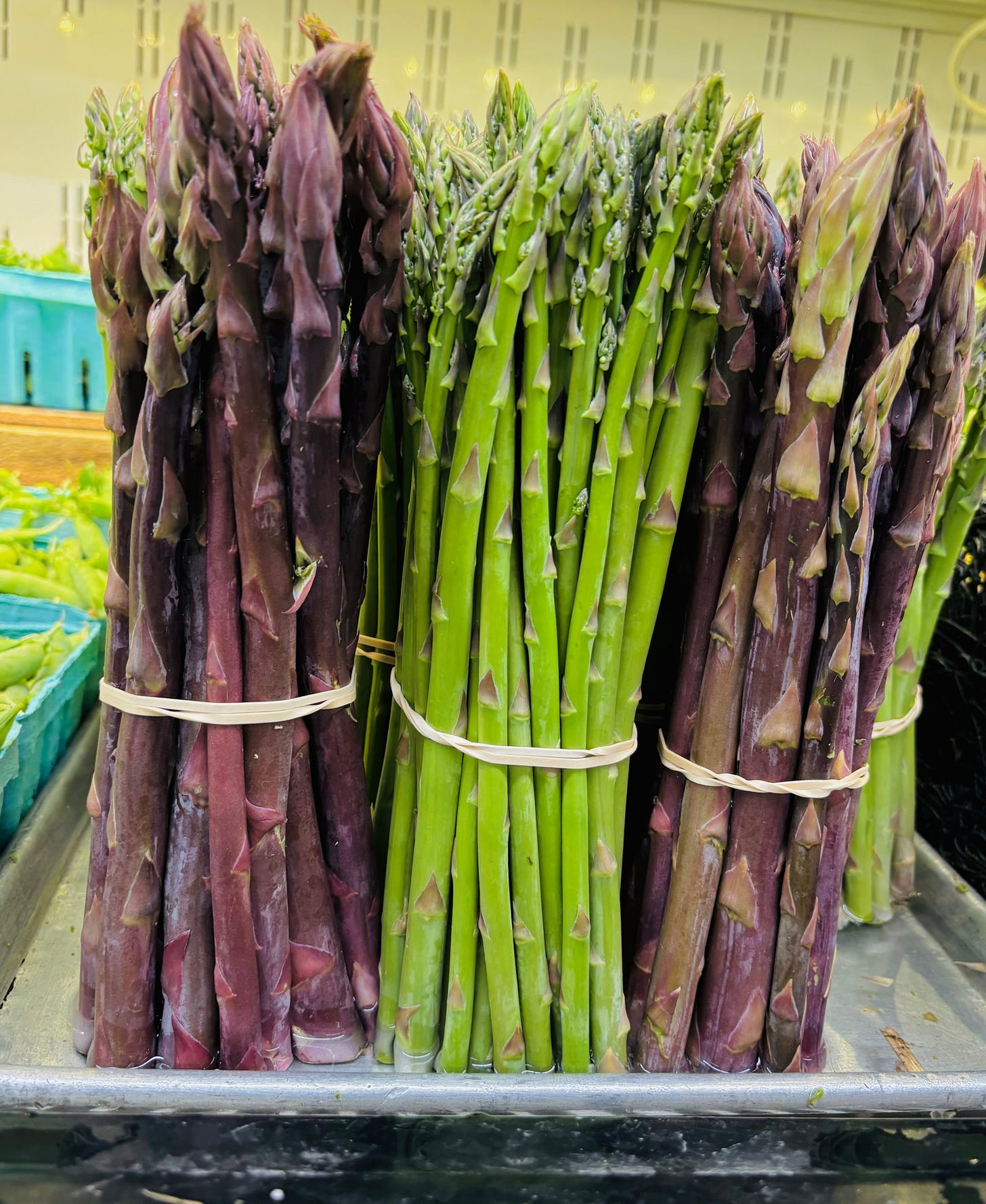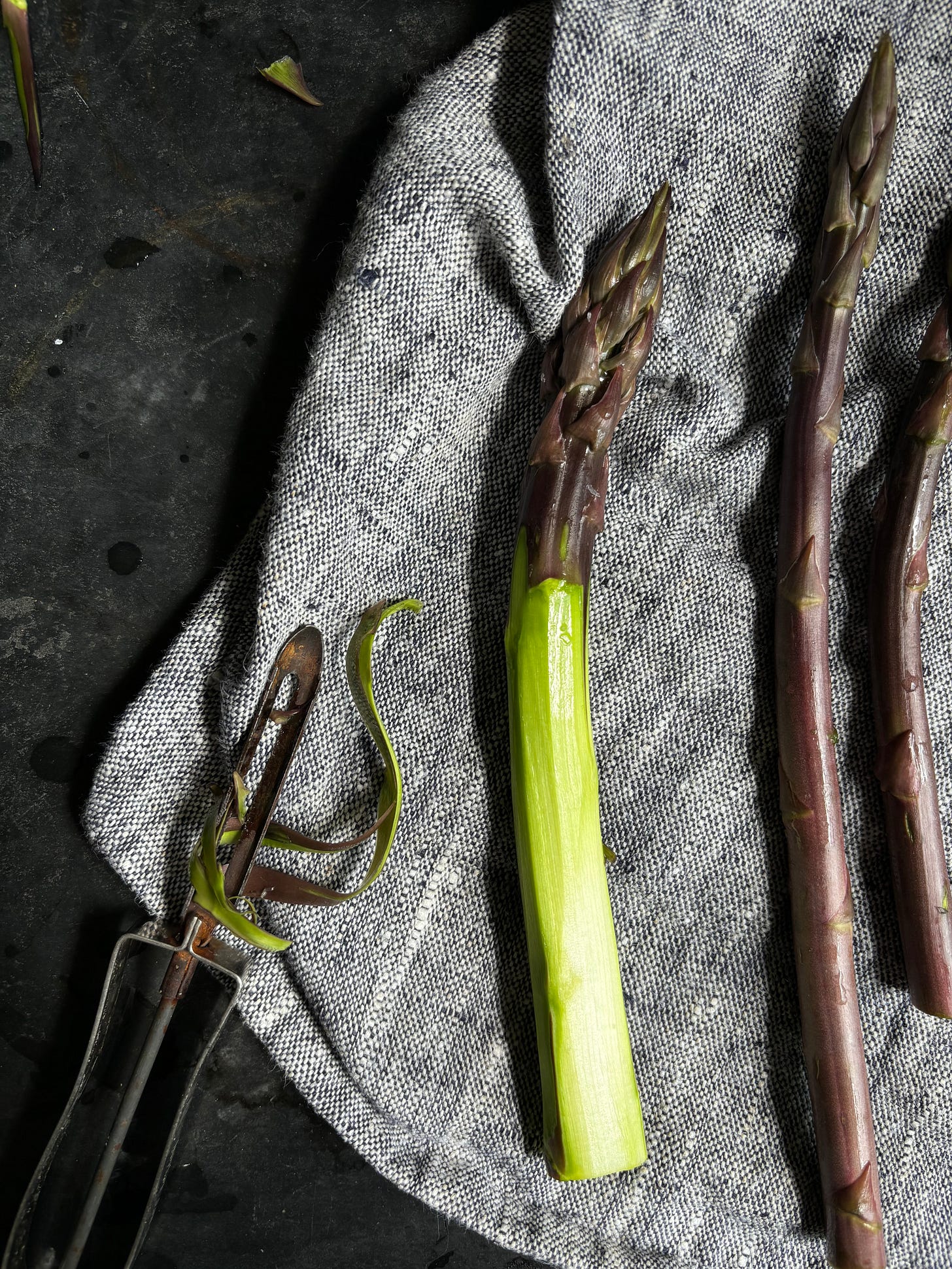Nothing in nature is created to be uniform, thankfully. Yet the bunches of asparagus we can buy from supermarkets hold spears of identical size. At farmers’ markets, they contain a medley of spears, tied together. Maybe you have a favorite. How do you cook them? If you cook them all the same way, for the same amount of time, you may not be getting the most of this (luxury) vegetable. We can always learn the best way to work with what we’ve got. Sometimes, though, we have a choice: Thick or thin– jumbo spears, or pencil asparagus? Purple or green? White??
In Paris I first saw the wispy, wild asparagus, asperges sauvages, at vegetable markets in Spring. Those stalks look almost like hops or wild green grasses, reminding me of my first chef-mentor, Jane. I worked with her at Upstairs at The Pudding, an elegant, green-walled restaurant in Harvard Square. She called all asparagus 'grass, short for aspagrass. What we used were uniform, standard-issue spears and we ordered them by the case. It was my job to call in the produce orders for the next day, and if we had a big private dinner scheduled for the Hasty Pudding Club members, we needed more than our nightly case: 3 cs grass, Jane would write, in sloping script on the legal pad that was our ordering sheet. Those cases were clever constructions: Vertical cage-like boxes that allowed the asparagus to breathe, with slats nailed across the ends. The asparagi (?) were tightly packed to keep them from jiggling around on the truck. When they arrived in the kitchen, we pried off the thin wooden slats, sometimes cracking and splintering the wood, and pulled out the handfuls of asparagus we needed to prep, before placing the remaining cases in the walk-in.
Cooking the asparagus in the restaurant was routine: We brought a large pot of water to a boil, shook a palmful of salt into it, prepared an ice bath in a hotel pan, and set it near the pot. Blanch the spears until bright green, lift out with a spider, drop in ice bath, lift out with spider, transfer to a dry hotel pan, all lined up in neat rows with tips facing the same direction. Later, during service, we would arrange three or five spears next to a lamb chop or veal cutlet; other times we’d chop the asparagus and stir it into a pan of risotto.
At home, you don’t need a special asparagus steamer, or a recipe. Just snap or trim off the toughest part of the ends, and lay the spears into a pan of salted, boiling water. I choose a pan wide enough to hold them horizontally, which saves time because the water comes to a boil so quickly.
Eat your asparagus spears piping hot, or, if eating them at room temperature, be sure to dress them right away with a drizzle of olive oil, so they can absorb some of the flavorful fat. Or, you can do it the restaurant way: Shock the cooked spears in ice water to preserve their bright, green color. In that case, don’t dress the chilled spears; keep them cool for dipping and eating later.
Pencil-thin asparagus is delicate compared to the standard asparagus we’re used to seeing. It’s what comes towards the end of the growing season (now–sigh). I tend to be impulsive about buying this type of asparagus when I see it– it’s so pretty, and seems less tame. But I’ve learned that it isn’t always my favorite. When I was working as writer and recipe-tester on the Via Carota cookbook, I was surprised when the chef and author Jody Williams told me that if pencil asparagus is delivered to the restaurant, she and her partner, Rita Sodi, aren’t super excited: “We say to each other: Ohhh, man. It’s the thin kind.” They opt to grill the thin kind. So, it was through working with the two chefs that I began thinking about the best ways to cook varying types of asparagus. Thin spears of pencil asparagus can be salted, tossed lightly with olive oil and placed directly on burning hot grill grates, or laid in a single layer in a cast-iron pan. They soften as they brown, and their flavor is intensified.
Fat spears of jumbo asparagus are another story. They have tender, juicy interiors; they love to be steamed or blanched. In catering kitchens I saw chefs peeling most of the green off the stalks and thought that seemed awfully fussy, even pretentious. Why bother? You don’t need to, and I didn’t bother for years. But the thing is, the tips will cook so much more quickly than the stalks. So if you don’t want mushy tips, peeling is advised (or a vertical steamer). As with all other sizes of asparagus, begin by snapping or slicing off the ends just at the point where they feel tough.
In the past couple of weeks I have been enjoying thicker asparagus stalks peeled because they take in butter and oil so nicely. Without the skin to interfere, what you get is completely silky in your mouth. For dinner one night, I peeled and chopped the spears into 1-inch lengths to toss with pasta. First I lightly browned butter- I wanted the nutty flavor of the brown butter, toasted hazelnuts and parmesan to coat the pasta.
It was really tasty, and not much effort to make a panful of restaurant-quality pasta for two. Maybe it’s worth taking the time to type this recipe up– so let me know if you’d be interested, and I will do it.
This weekend, I was thrilled to find plump, purple asparagus and tender, slender green ones in my local farm store, Samascott’s, in Kinderhook, NY. Because they are further north, their growing season is usually two weeks behind NYC. So even though the end is near, you can still get the freshly harvested grass.
Notice that the farm store keeps water in the bottom of the tray to keep the asparagus fresh while it’s in storage. I do the same at home.
I peeled the thick stalks, and didn’t peel the thinner ones. I dropped them in a shallow pan of boiling, salted water, letting the thick spears cook for a little bit longer than the thin ones. Once cooked, I tasted purple and green side by side– and I have to say, I think the purple ones were sweeter, and more delicate in flavor. Like (seemingly) all purple vegetables, the asparagus turned green when cooked. But I didn’t need to cook them to know that: As soon as I peeled the purple skin from an asparagus spear, its true, vibrant green was revealed.












I don’t know and now I want to find out. I will try and go to the local farmers market tomorrow and scout around.
I’m so hungry for asparagus from reading this. If you have time to write the pasta asparagus recipe I’d love to try it. It’s my favourite vegetable.